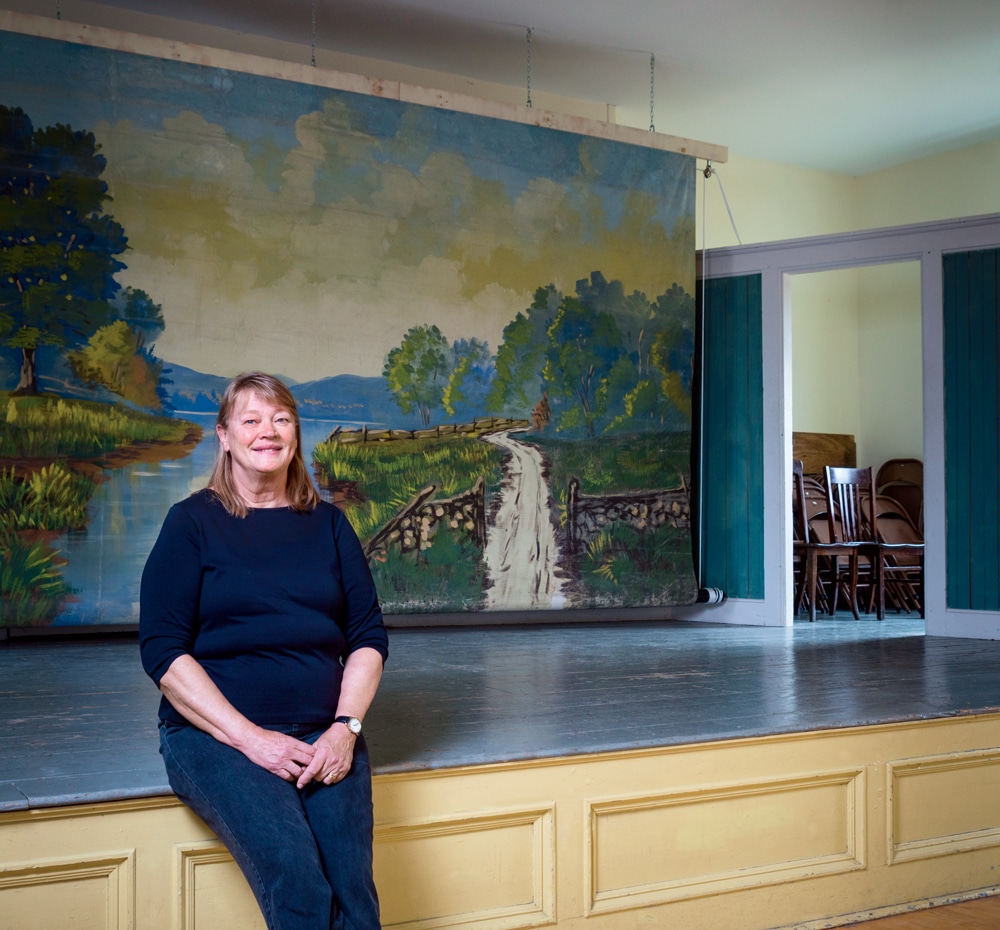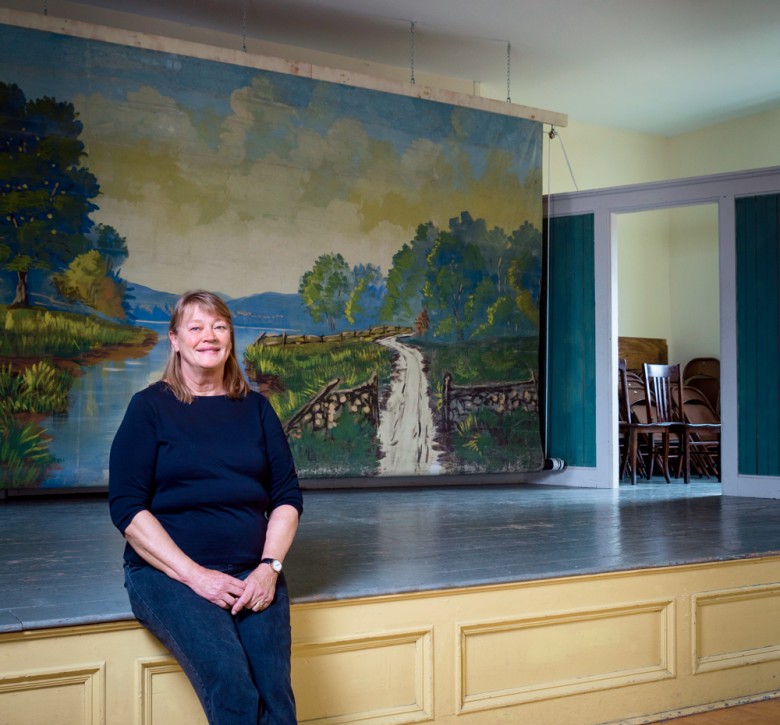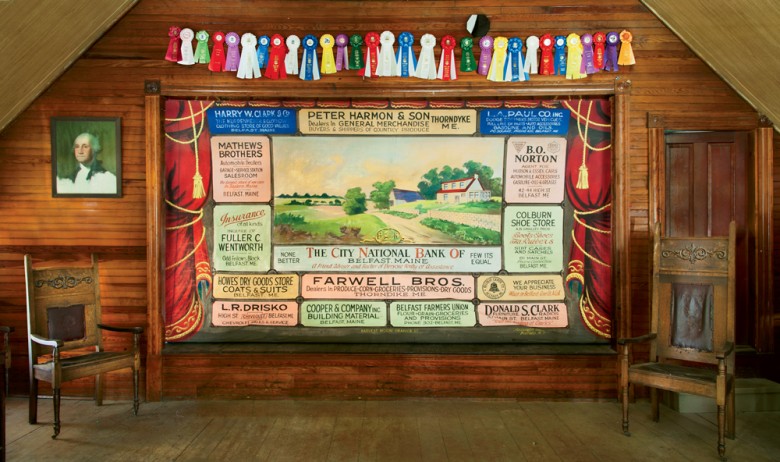‘Each One is Worth Saving’ | Painted Theater Drapes Traditionalists
Christine Hadsel of Vermont’s Curtains Without Borders is on a mission to repair and restore a historic American resource: the classic artistry of painted theater drapes.

Chris Hadsel, executive director of Curtains Without Borders, with one of her restored theater curtains in Cornwall, Vermont. The piece was originally painted for the town of Whiting, but when the town hall’s upstairs theater was closed, Hadsel brokered the curtain’s permanent loan to nearby Cornwall. “It was lying on the floor when we got it,” she says, “the only one of a group of curtains that survived. It was so filthy we weren’t even sure what was on it.”
Photo Credit : Corey Hendrickson
Photo Credit : Corey Hendrickson
All odysseys have a beginning, and this one begins inside a rundown brick building in a town in northwestern Vermont.
This is before the big grants and lecture invitations. Before the thousands of miles she traveled, hunched over a steering wheel, crisscrossing northern New England. Before all those treks through forgotten attics and back rooms. Before the radio and newspaper interviews. And yes, before the letters and phone calls, trickling in from underfunded historical groups asking, even pleading: Can you help us reclaim a bit of our past?
It’s a spring day in 1993, and Christine Hadsel is making her way inside the abandoned Vergennes Opera House, past the rubble of chunked-out wall plaster, across moaning floorboards, under smashed windows that invite flocks of pigeons in. She’s looking for the second-floor theater, to see an artistic oddity.
As director of the Vermont Museum and Gallery Alliance (VMGA), a Burlington nonprofit that has helped museums care for their collections, she has come here at the request of a group working to save the opera house. There’s a grand drape, she’s been told, of which little is known. Can she tell whether it’s worth preserving?
“It was on the stage, propped up against the back wall,” Hadsel recalls. “This enormous thing, so dirty you could hardly see what was on it. It was filthy and torn, and it had a big hole where somebody had stepped through it.”
But through all that grime Hadsel caught glimpses of the painting’s grandeur. The way a splash of evening light hit a mountain peak, a woods-and-water scene so lifelike she wanted to step into it. It spoke of a kind of promise and potential for the space around it. A past that showed a possibility for the future. As she settled into her car for the hour-long drive home to Burlington, Hadsel wondered whether there were more paintings like it. What sort of history did these neglected public buildings, once so central to rural community life, hold? What was at risk of vanishing once they disappeared?
She didn’t know it then, but on that April day Hadsel had pricked the surface of a vast body of public art that had largely been forgotten. A century ago, in grange halls and churches, town halls and performance buildings, theater curtains were the central pieces of public art in small towns across New England. From the late 1800s to the eve of World War II, they formed the colorful backdrops and scene setters for weddings and concerts, plays and town meetings. Some were created by big-city production houses, others by itinerant artists who schlepped their brushes and imagination from town to town. Their styles were as varied as the buildings where these paintings hung: simple rural scenes, vibrant downtown portraits, fantastic displays of castles and kings. Nobody would confuse them with a Rockwell Kent, but they weren’t Dogs Playing Poker, either, and their history sheds some light on small-town life before televisions and automobiles hollowed towns out.
Soon after returning from Vergennes, Hadsel wrote every town clerk and historical society in the state to ask about their historic theater scenery. She filed responses in a shoebox, and then, using a small grant from the National Trust for Historic Preservation, she deployed two preservation experts to measure and take pictures of the paintings.
“I had no idea where it would lead,” Hadsel says. “I thought maybe we’d find 25 curtains. But then as we started to look, it became 35, then more.”
The project now consumes her life. In 1998 she left VMGA to launch Curtains Without Borders, a nimble nonprofit of preservation experts devoted exclusively to restoring historic scenery. Hadsel is its executive director. To date the group has restored nearly 200 curtains, many of them in Vermont, but a fair number in New Hampshire, Maine, and Massachusetts, as well as several others from around the country. She’s given talks and shown her work across the U.S., been featured on NPR, and in 2015 published a gorgeous coffee-table book, Suspended Worlds, about the paintings. Over the past decade and a half, Hadsel has made herself an expert on an art form that desperately needed a champion. Along the way, she’s shown that these works and the buildings where they make their home aren’t strictly relics from the past. There’s a place and an importance for them in the modern world, too. Perhaps even a critical one.
“These curtains may not be the highest art you’ve ever seen, but most are more than easy on the eye,” she says. “And they’re the focal point of the community hall, which is the focal point of any community. Even now. People who are just getting their entertainment from little phones, they’ll be back. They’ll see how important these places are and how each one is worth saving.”
—
The main room inside the town-hall building in Lyndeborough Center, New Hampshire, resembles something like a middle-school art room. Chairs have been shoved to the side of the space, and down the middle sits a long table covered with a toolbox of paints, a couple of tape measures, different kinds of papers, rope, scissors, and a few rolls of duct tape.
Set in the historic hamlet of a town of just 1,800 residents in southern New Hampshire, the town hall is what you’d expect of one built in New England in the mid-19th century: a white-clapboard box with large windows and green shutters. Inside, sloping wood floors, a white tin ceiling, a small stage, a modest balcony, and big windows define the main room.
Under one set of windows, the hall’s main curtain, a 17-foot-long idyllic country scene of birches, lake, and mountains, is sprawled across three tables jammed together. It’s a Wednesday in early November, and Hadsel and her team are in the second day of a two-day project to restore the painting. Hours went into cleaning and stitching. Quietly hunched over the painting, Mary Jo (“MJ”) Davis, a paper conservator who’s worked with Hadsel from the start, dabs at the lake with a small paintbrush, gently retouching worn and water-stained spots. Until recently, the painting, created around 1900, was rolled up in a back room and weathered the effects of the hall’s leaky roof.
Hadsel is a more vocal presence. Tall, with shoulder-length hair and large blue eyes that grow bigger when she’s excited, Hadsel is a steady stream of project details. Backing-board measurements. Rope-hanging length. Will the old hanging rollers suffice? In between, talk delves into a set of large curtains in Hopkinton, New Hampshire, that her group recently worked on. They’re to be displayed this week, and Hadsel is nervous about how it will go.
“If I saw them [putting them] up, I’d be a wreck,” she says. “I actually woke up early and sent out an email with some suggestions on how to attach the rope.” She nods her head. “I don’t know, but at 4:00 a.m. it seemed like a good plan.”

Harvest Moon Grange #57, Thorndike, Maine, designed by Anderson Scenic Company, Buffalo, New York, c. 1935.
Photo Credit : Carolyn Bates
Like many small towns, Lyndeborough lacks much slack in its budget for this kind of project. Which makes Hadsel’s group so attractive. She’s fanatical about keeping costs in check. On this morning, she’s relieved to find that the warm day means she won’t have to run the furnace. Hadsel’s approach is also more hands-on. The restoration is done on site, and by leveraging grants and local volunteers, she can limit a community’s cost. When Vergennes’ grand drape was restored, the conservation lab that did the work charged $30,000. Hadsel’s bill to Lynde-borough will be a tenth of that. No, the finished product isn’t the same. It will still have blemishes and imperfections, but the grime will be gone, the tears fixed, the details allowed to pop again. “The goal is to get everything up to the same level,” Davis explains. “Not to overdo any one section. So it might still look old, but if you can look at it from 20 feet away and the scene holds together, that’s good.”
The fact that it won’t be museum quality is kind of the point. Hadsel’s aim isn’t something so precious that it has to be locked away and used only on special occasions. Her curtains are what they were meant to be: functional and accessible. They’re reinstalled on their old creaky rollers, and she doesn’t cringe at the idea of people putting their hands on them. Maybe in another 60 years they will need to be restored again. That’s just the way it goes. “Most of the artists who made them never imagined they’d be around this long,” Hadsel says.
For the 68-year-old Hadsel, the work of bringing back these public paintings is the culmination of a life that has indirectly pointed her down this path. Her father worked in the foreign service as an African specialist. Moving was a constant. London, Somalia, Ghana, and Ethiopia—it was hard to put down roots. As such, Hadsel packs a passion for the power of community. Which she found in Vermont. That’s where she and her husband, Bill Mares, a writer, escaped to from Chicago in 1971 on the premise that property was cheaper, the summers cooler. Since then Hadsel has immersed herself in social-service work and the arts. She’s found the hometown community she missed as a girl, and through the paintings, has helped small towns rediscover theirs.
“Chris saw the talent that went into making these curtains, but she also realized that saving these works was a way for people to get interested in places like the grange halls again,” says Rick Kerschner, who headed the conservation department at the Shelburne Museum for more than 30 years and now serves on the board of Curtains Without Borders. “It’s gotten people excited about what they have, and because of it some of these places have been restored.”
Hadsel is a catalyst, a team builder. Her organization doesn’t swoop in like some kind of savior to ply its secret methods. Instead, she brings the community into a process by inviting residents to help with the work and to share her knowledge. It gets them invested in the curtains and by extension the old town hall. They may see something they’ve seen so many times before in a different way.
By late morning, the Lyndeborough curtain’s old backing board has been pried off the backstage wall (“Grangers were never shy about using nails,” Hadsel jokes). Then, with Al Gibson, a retired firefighter, Hadsel lines up a new plank atop the painting, and they set about mounting it. Gibson drills out screw holes, while Hadsel follows behind setting in long screws. “This is Shop 101—how to hang a curtain,” she says with a laugh.
By early afternoon, a small team begins mounting the curtain back on the stage for the first time in decades. When it’s finally up and true, Hadsel steps back to the center of the room to take in the scene.
“Oh, MJ,” she gushes. “It’s a sweetheart of a little curtain.” She lets out a small sigh. “When we first started, it was so dirty, and I wondered if it was really worth bringing back.” She looks at it in silence for several seconds and then smiles. “But yes, it was. That’s the satisfaction you get from doing this. You take something that needs care, clean it all up, and you’ve suddenly got something quite wonderful.”
For more information, see Suspended Worlds: Historic Theater Scenery in Northern New England, by Christine Hadsel (David R. Godine, 2015).
To inquire about curtain restoration, visit: curtainswithoutborders.org
Ian Aldrich
Ian Aldrich is the Senior Features Editor at Yankee magazine, where he has worked for more for nearly two decades. As the magazine’s staff feature writer, he writes stories that delve deep into issues facing communities throughout New England. In 2019 he received gold in the reporting category at the annual City-Regional Magazine conference for his story on New England’s opioid crisis. Ian’s work has been recognized by both the Best American Sports and Best American Travel Writing anthologies. He lives with his family in Dublin, New Hampshire.
More by Ian Aldrich

